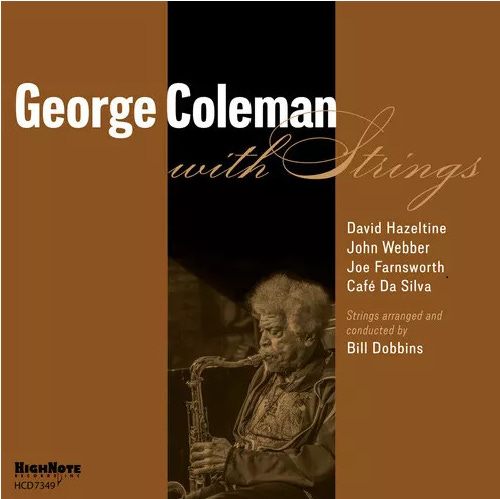George Coleman - George Coleman with Strings
(HighNote Records, 2025)
Saxophonist George Coleman is a journeyman musician. He has performed and recorded as the consummate sideman for the past. He began performing in the early 1950s when he worked with Ray Charles and B.B. King before moving to Chicago in 1956 and working with Gene Ammons and Johnny Griffin. Coleman spent a year with Max Roach’s quintet, during which he also recorded with Jimmy Smith (House Party (Blue Note Records, 1957) and The Sermon! (Blue Note Records, 1958)), and Lee Morgan (City Lights (Blue Note Records, 1957)). He moved to New York City with Max Roach, then played with Slide Hampton (1959–1962), Ron Carter, Jimmy Cobb, and Wild Bill Davis (1962) before joining the Miles Davis quintet from 1963 to 1964.
Coleman’s time spent with Miles Davis falls within the evolutionary period between the sextet that recorded Kind of Blue (Columbia Records, 1959) and the emergence of his second great quartet with Herbie Hancock, Ron Carter, Wayne Shorter, and Tony Williams. This was a pivotal time for Davis and a time of significant growth for Coleman. The saxophonist spent the 1970s and beyond addressing his own recording while teaching at the New School, Long Island University, New York University, and Mannes School of Music. The National Endowment for the Arts named Coleman an NEA Jazz Master in 2015.
Following his recent well-received releases, George Coleman Live at Smalls Jazz Club (Cellar Music Group, 2023) and Big George (Smoke Sessions, 2024), the saxophonist releases George Coleman with Strings. It has long been a dream of jazz musicians to record with a string section, a dream that has resulted in recordings such as Charlie Parker With Strings (Mercury Records, 1950), Chet Baker with Strings (Columbia Records, 1954), Clifford Brown with Strings (Emarcy, 1955), Stan Getz Focus (Verve, 1962), Art Pepper Winter Moon (Galaxy Records, 1981), and Roy Hargrove Moment to Moment (Verve, 2000) are evidence of the format’s continuing popularity.
What makes Coleman perfect for a strings recording (aside from his 60 years of music making) is his big, cordial tone, which comes through with a brusque tone that is rounded about its edges and solid through its middle — a perfect ballad tone. That is what Coleman brought with him to Van Gelder Recording Studio just before Christmas 2022. With him also came his working quartet: pianist David Hazeltine (who replaced the late Coleman’s childhood friend Harold Maburn), bassist John Webber, and drummer Joe Farnsworth. The recording had several moving parts. The quartet laid down the basic tracks, with the strings following, recorded at The Studios at Linden Oaks in Rochester, New York, in April 2023. Trading 8s Recording Studio in Paramus, NJ, recorded the percussion of Café da Silva in August 2023, with everything coming together at Trading 8s and the final mastering completed at the Bass Hit Studio in NYC.
Five standards comprise the recording, with two (“A Time For Love” and “Ugly Beauty”) being presented with full orchestra introductions. The string orchestra arranged and conducted by Bill Dobbins, features 5 first violins, 4 second violins, 2 violas, and 2 cellos. Dobbins’ attention to detail produced a conservatively scored accompaniment that operated to support the soloist within the confines of his quartet. The string scoring allowed Coleman to stretch out and take his time developing his ideas within each composition.
The disc begins in full ballad mode with Sammy Cahn’s “Dedicated to You.” The briefest piece on the disc, Coleman sounds relaxed and engaged working within the small confines of the song. Henry Mancini’s “Moment to Moment.” The arrangement gives the piece a light tango rhythm that beckoned for the percussion skills of Da Silva, who added bongos and shakers to great effect. David Hazeltine delivers a melodic and grounded solo leading into a rousing coda. The Mandel/Webster“Stella by Starlight finds Coleman completely settled in for the ballad ride, lush and languid. The Mandel/Webster tune “A Time for Love” and Thelonious Monk’s “Ugly Beauty” have two readings differing by extended string introductions. These are moody renderings with shadows hiding glimpses of light, noir-toned and deeply introspective. This is an impressive autumnal release by a seasoned professional who is receiving his justified attention.



